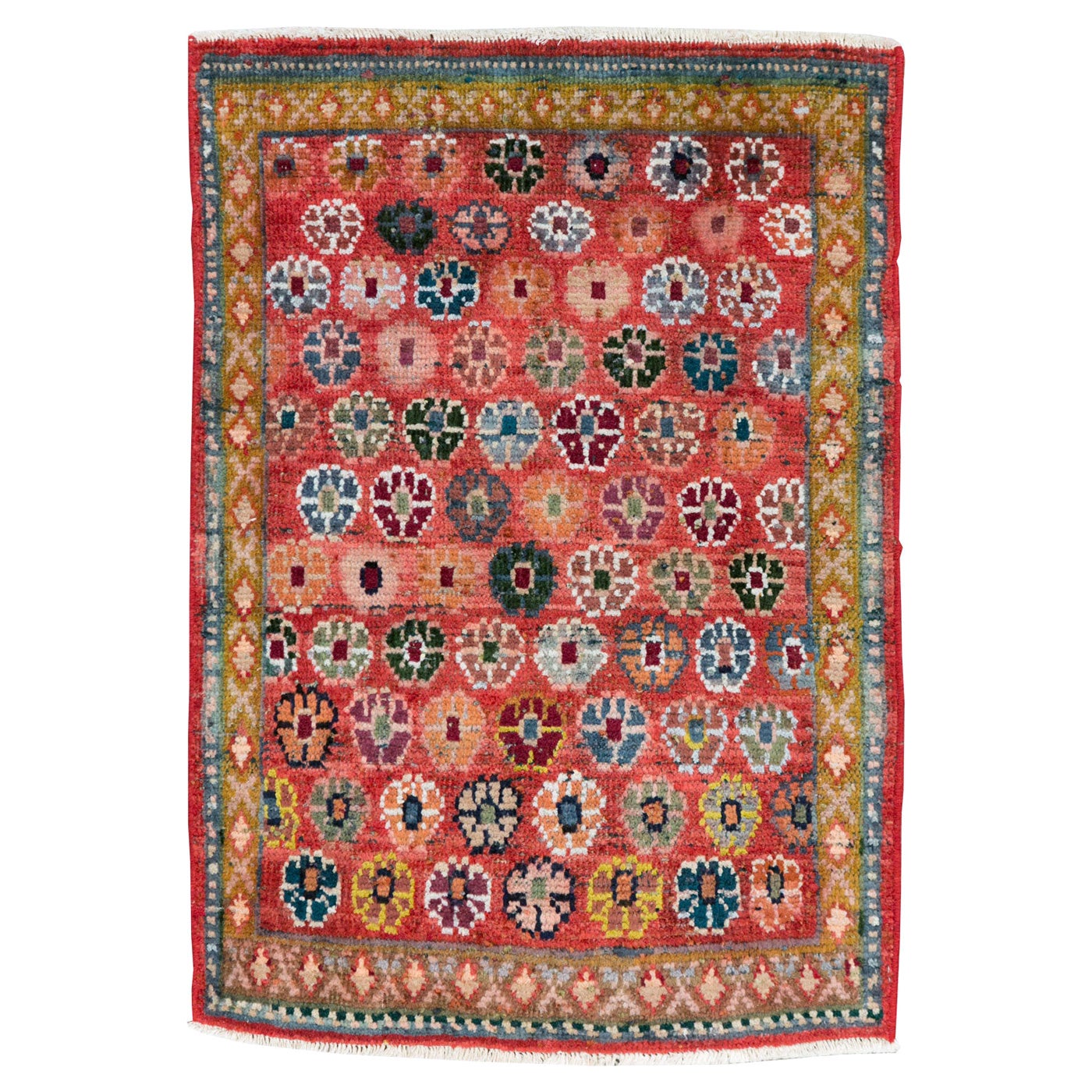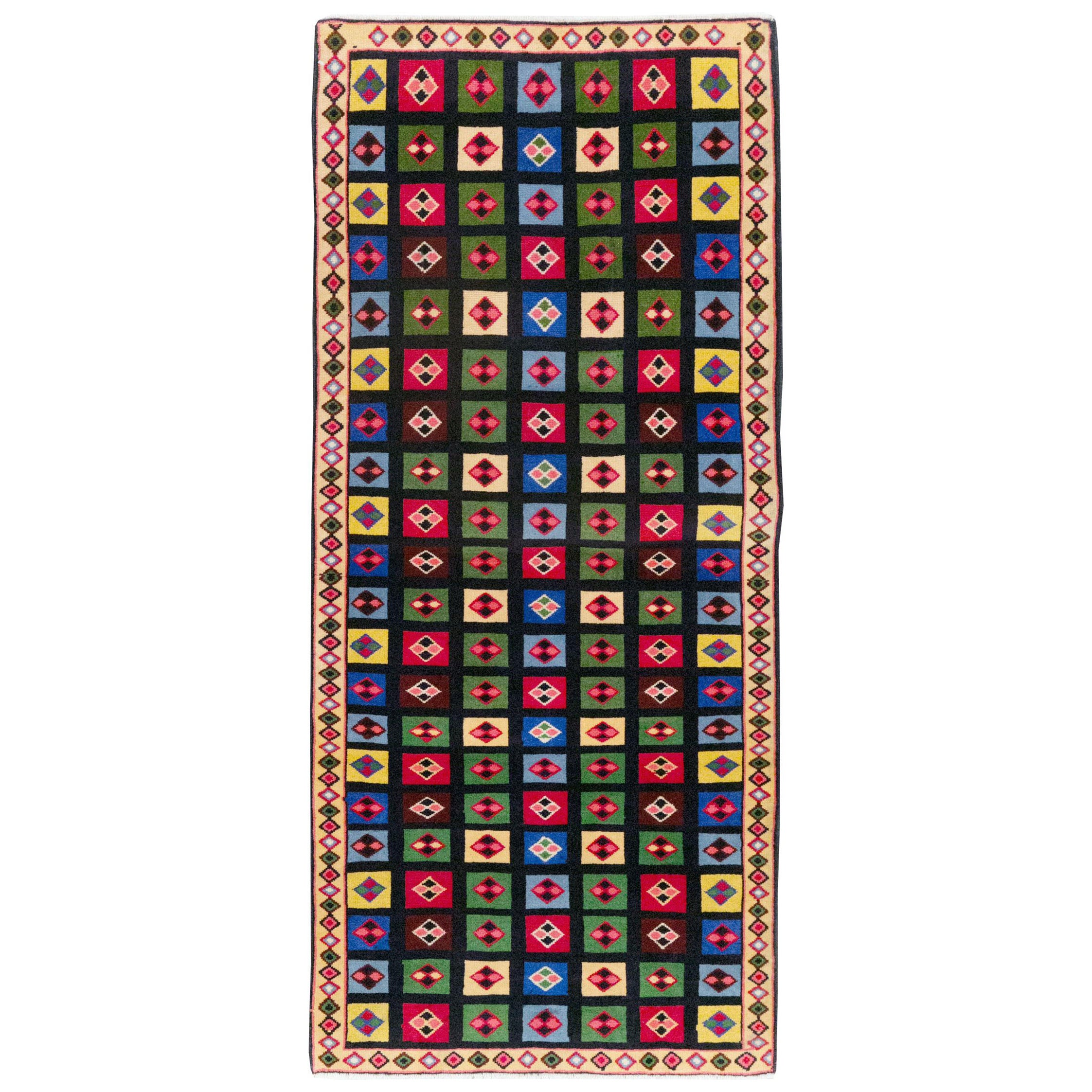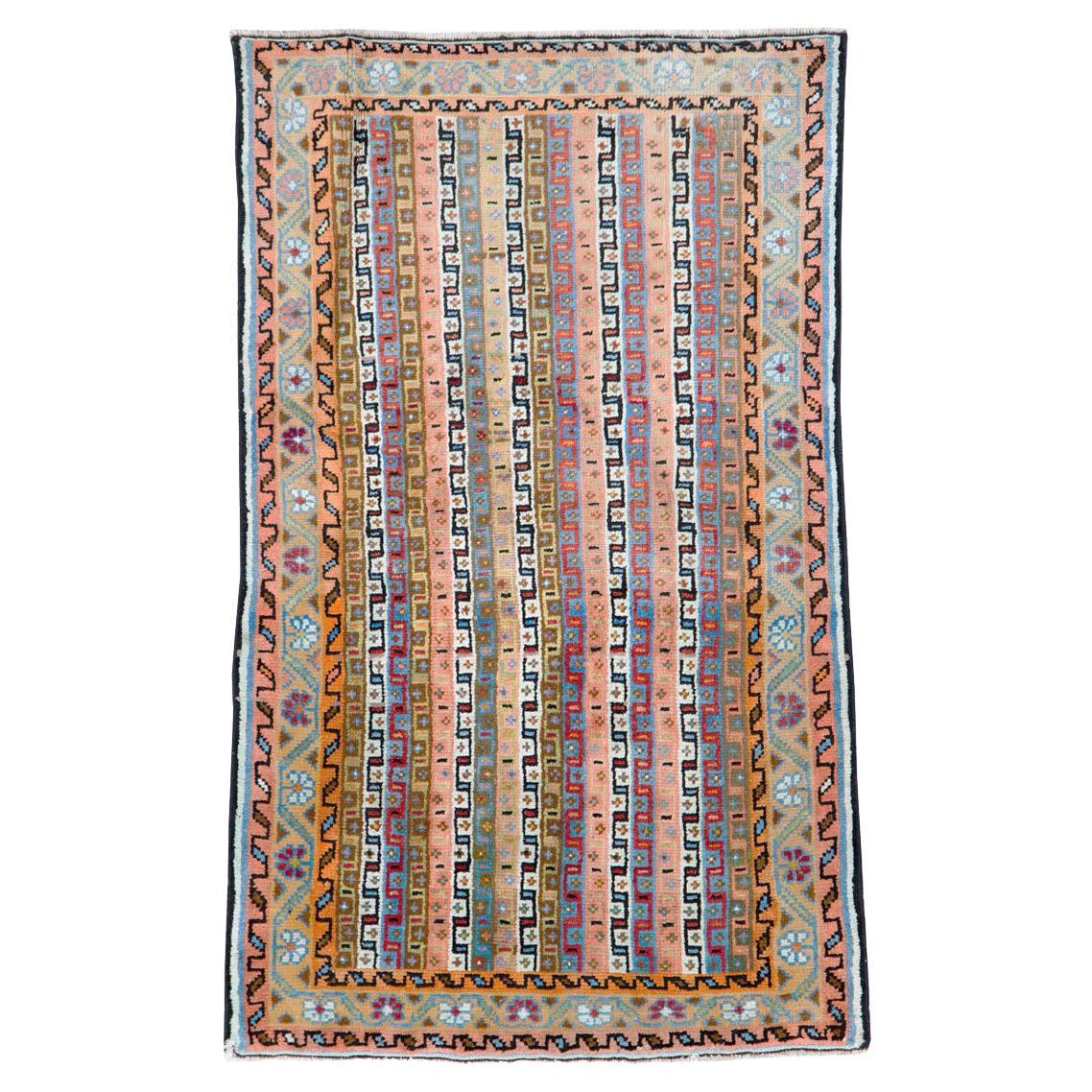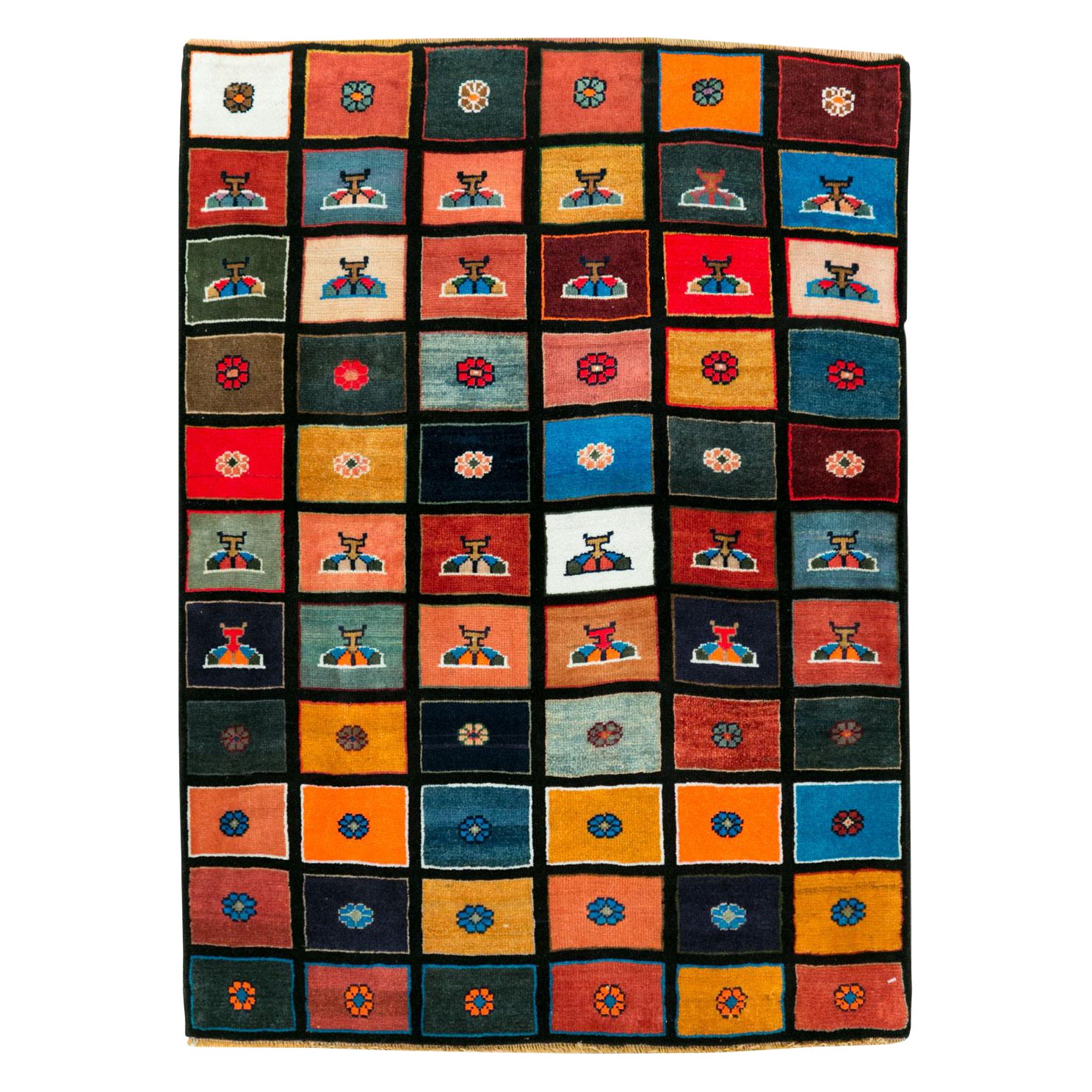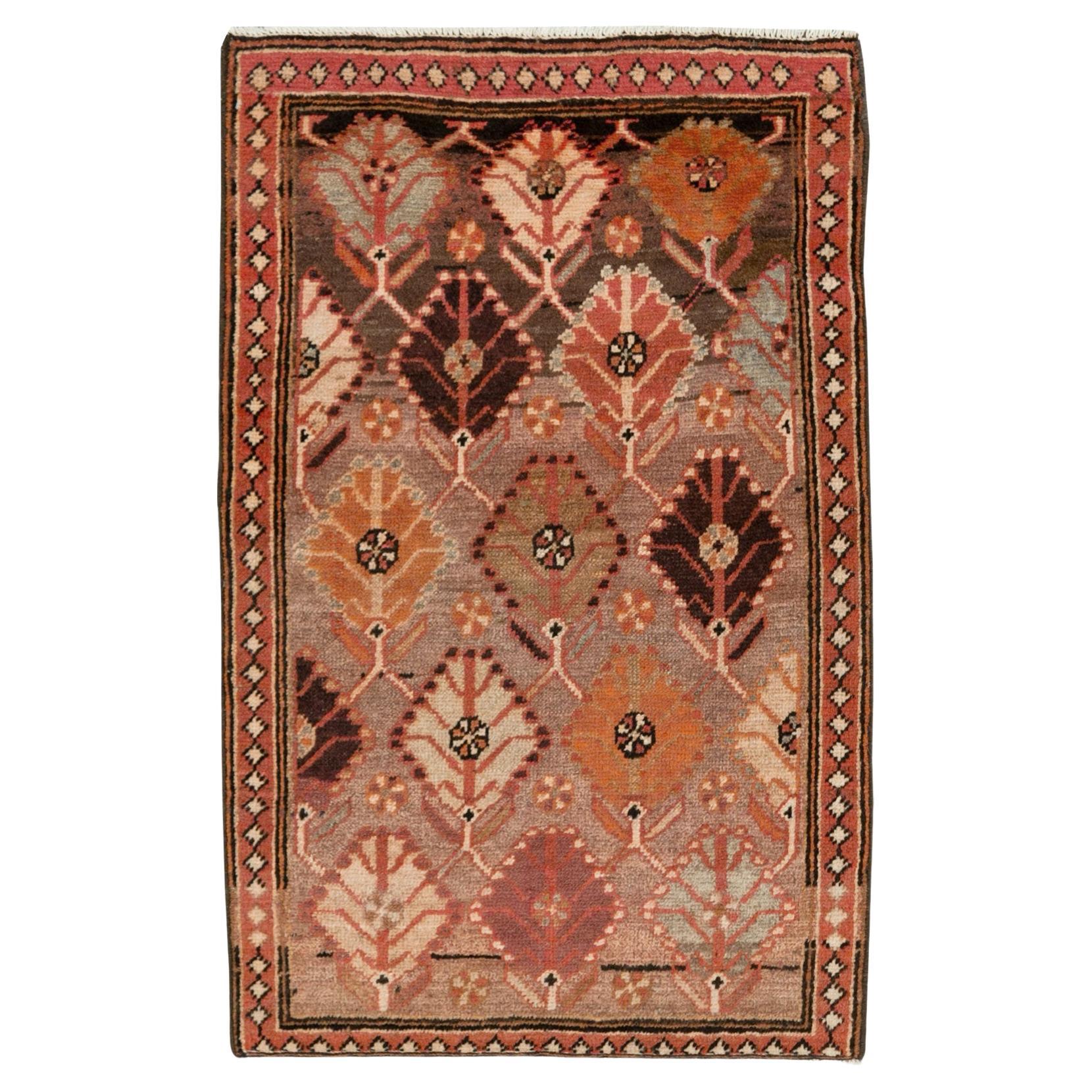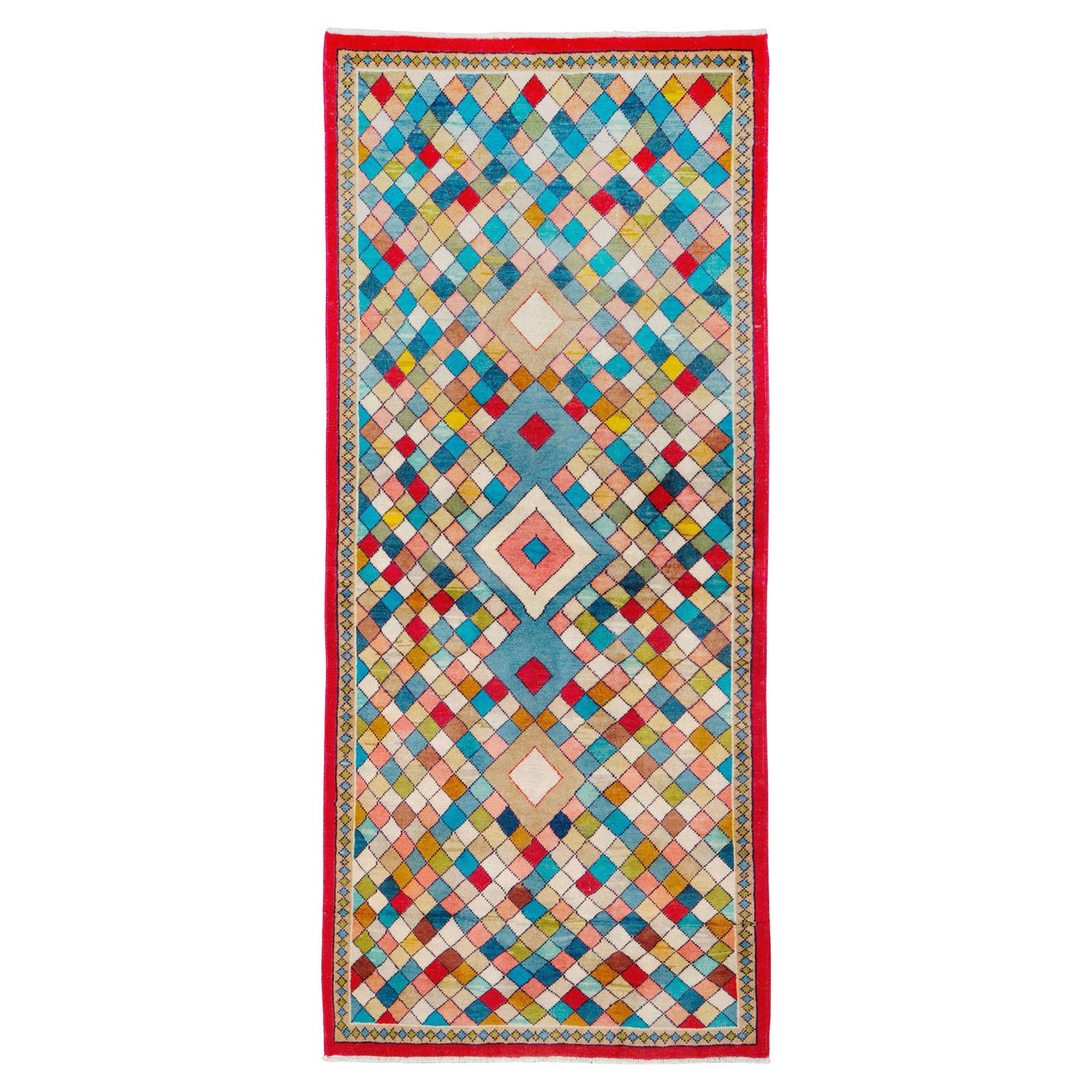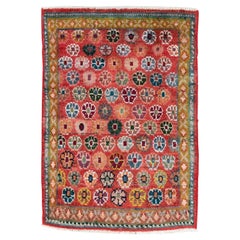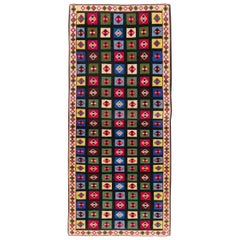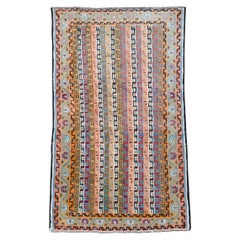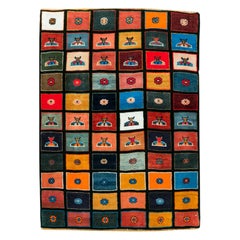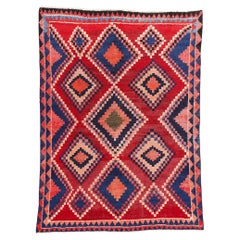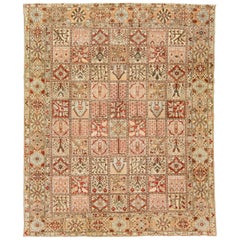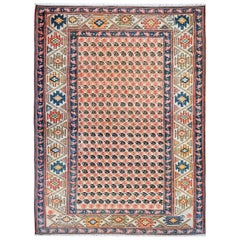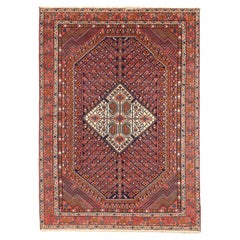Items Similar to Contemporary Mid-20th Century Handmade Persian Mahal Throw Rug
Want more images or videos?
Request additional images or videos from the seller
1 of 9
Contemporary Mid-20th Century Handmade Persian Mahal Throw Rug
$3,875
£2,929.02
€3,365.96
CA$5,395.91
A$6,002.73
CHF 3,146.71
MX$73,351.93
NOK 40,069.40
SEK 37,719.79
DKK 25,125.65
Shipping
Retrieving quote...The 1stDibs Promise:
Authenticity Guarantee,
Money-Back Guarantee,
24-Hour Cancellation
About the Item
A vintage Persian Mahal throw rug handmade during the mid-20th century with a colorful and contemporary diamond lattice pattern over a red field. The diamond pattern extends into the cerulean blue border.
Measures: 3' 3" x 4' 0"
Persian Rugs & Carpets:
Persia (Iran) is a moderately large country with a very long history and an enormous art/craft/industry built around the handmade carpet. Until the discovery of oil, carpets were the largest Persian export. The craft goes back to ancient times, although the history is more broken than one might expect or desire. The Pazyryk rug dates from the 3rd/4th century B.C.E., but really no carpets before 1500 or so survive in any sort of numbers. Persia is an upland plateau region, semi-arid in many places, verdantly fertile in others, and a perfect base for a pastoral economy. Sheep beget wool and wool begets rugs. Lots of rugs. Almost every province, city, town, village and tribe made or makes rugs with distinctive local characteristics. The rug literature identifies many of these, but thousands of more locales and tribal segments cannot be connected to known examples and vice versa.
There are essentially three (or four) distinct rug genres: the urban workshop formal rug; the village informal type; and the tribal/nomadic really informal kind. A fourth type is the royal or imperial carpet, woven for the Shah in court ateliers. Workshop, village and tribal rugs will be considered in more depth in specialized essays. Persian rugs must be woven in Persia. Being “in the style of….” does not count. On the other hand, the universally high standards of Persian rug weaving have raised the levels of carpet craftsmanship all over the rug belt. Everyone wants to be Persian, at least where rugs are concerned. “Persian rug” and “Oriental rug” used to be synonymous.
Persian rugs come in all grades. From ultra-coarse tribal rugs to incredibly fine silks from Tabriz and planned urban Isfahan pieces. Persian rugs also come in all sizes. From miniature throw rugs to pieces as large as a parking lot. In weaves from 20 knots per square inch to 2000; in wool, silk, combinations thereof, and more modern synthetic and natural fibers. With natural and synthetic dyes. Most Persian weavers are women, in all contexts, but everybody can weave rugs. The Great Persian Carpet Revival began in the 1870s and the industry mushroomed, with many cities, villages, and tribes taking up or radically expanding rug weaving, from an occasional domestic art to a full-time professional industry. For example, Tehran, the capital, developed an industry-oriented exclusively toward very fine, totally designed carpets for the nascent Persian upper classes. A few rugs were exported, but most went to the wealthy. But this industry did not last past the Interwar period. Other cities have been weaving rugs for centuries. Tabriz, an early capital, has been weaving fine rugs since the 16th century, and with an interruption, has a flourishing industry today. Other cities developed carpet industries as demand expanded around 1900. Before then, nothing much in Mashad, after that lots of activity. Towns like Nain and Qum started from nowhere in the ’30s and now have crafts wholly oriented toward high-quality pieces.
Villages all around Persia have contributed their share to the middle market, but 20th century (and later) pressures have pushed them toward higher qualities, more in the urban manner. This quality upgrade has also affected the nomadic, tribal weavers. Once weaving a few rugs for themselves for domestic consumption, they are now almost exclusively weaving for the market and in competition with urban rugs. So, they have moved up in quality and style.
The Persian carpet is not a static kind of thing, and neither is the craft supporting it. Forget the “timeless east”. Rugs are objects of fashion, with innovations beginning at or near the top, and working their way downward as styles become accepted. Because rugs are a worldwide export, foreign influences seep or crash in. Whole new genres are imported. The red “American Sarouk” detached floral spray style was imported around 1920 and quickly became popular all over Iran, in scatters, room sizes, and runners. Not Persian, but “Persian”. Now accepted everywhere. Rugs are viewed in Iran as art objects, and artists everywhere have always taken advantage of innovations in techniques and materials. In Persia, this has meant machine-spun threads and yarns, synthetic dyes, and chemical washing manipulation. Some experiments lead to real improvement, some are unfortunate dead ends. Some patterns are wildly successful, others are quickly discarded. The allover Herati, Mina Khani, Boteh (paisley or cone), and Gol Hennai patterns have proliferated, and the medallion and corners layout in its infinite variety is virtually synonymous with Persian rugs. Persian weavers seem to have invented all these and more. Today, very finely woven photographic pictorials are fashionable. Who knows if this innovation will last?
A basically semi-desert land needs color, has to have color in its furnishings and household accouterments. Persian rugs are all about color. All types revel in true color: saturated reds, deep blues, salmon, sky blue, cerulean, yellows from mustard to lemon, near black, cream and ecru and ivory, greens from teal to turquoise. From the Orient comes light, and light means color. A real, genuine Persian rug is richly, complexly colored. Maybe too rich. The carpets of the Chahar Mahal (“Bakhtiari”) area are just too colorful, too saturated for the American market. But they go over just fine in Persia. No blah rugs there. Current American decorating trends have shied away from color, complexity, and boldness. Whether these are “coming back” is a question. They have never gone away in authentic Persian rugs.
A tour of the country shows urban weaving centers around the border edge, with a central spine; village weavers in the countryside surrounding the cities; and tribal weavers filling the blank spots almost everywhere. Some towns have been continuously active for centuries, like Kerman; some with interruptions like Isfahan, Kashan, or Tabriz; and some are relative newcomers like Qum and Nain. The picture is incomplete and much of the 18th and 19th centuries have been long ignored. There are large gaps with no extant specimens. But also, discoveries of previously ignored tribal and village weaving keep coming. New types get explored and the picture fills in. Whatever story you believe, it is probably only a fraction of the rich history of the Persian carpet.
About the Seller
5.0
Gold Seller
Premium sellers maintaining a 4.3+ rating and 24-hour response times
Established in 1989
1stDibs seller since 2009
595 sales on 1stDibs
Typical response time: 1 hour
- ShippingRetrieving quote...Shipping from: New York, NY
- Return Policy
Authenticity Guarantee
In the unlikely event there’s an issue with an item’s authenticity, contact us within 1 year for a full refund. DetailsMoney-Back Guarantee
If your item is not as described, is damaged in transit, or does not arrive, contact us within 7 days for a full refund. Details24-Hour Cancellation
You have a 24-hour grace period in which to reconsider your purchase, with no questions asked.Vetted Professional Sellers
Our world-class sellers must adhere to strict standards for service and quality, maintaining the integrity of our listings.Price-Match Guarantee
If you find that a seller listed the same item for a lower price elsewhere, we’ll match it.Trusted Global Delivery
Our best-in-class carrier network provides specialized shipping options worldwide, including custom delivery.More From This Seller
View AllMid-20th Century Handmade Persian Mahal Small Throw Rug
Located in New York, NY
A vintage Persian Mahal small throw rug handmade during the mid-20th century.
Measures: 2' 0" x 2' 10".
Category
Mid-20th Century Persian Modern Persian Rugs
Materials
Wool
Mid-20th Century Handmade Persian Mahal Throw Rug
Located in New York, NY
A vintage Persian Mahal throw rug handmade during the mid-20th century.
Measures: 2' 4" x 5' 1"
Category
Mid-20th Century Persian Modern Persian Rugs
Materials
Wool
Mid-20th Century Handmade Persian Mahal Throw Rug
Located in New York, NY
A vintage Persian Mahal throw rug handmade during the mid-20th century.
Measures: 2' 3" x 3' 8".
Category
Mid-20th Century Persian Modern Persian Rugs
Materials
Wool
Mid-20th Century Handmade Persian Mahal Throw Rug
Located in New York, NY
A vintage Persian Mahal throw rug handmade during the mid-20th century.
Measures: 2' 6" x 3' 6".
Category
Mid-20th Century Persian Modern Persian Rugs
Materials
Wool
Mid-20th Century Persian Malayer Throw Rug
Located in New York, NY
A vintage Persian Malayer throw rug handmade during the Mid-20th century.
Measures: 2' 1" x 3' 2"
Category
Mid-20th Century Persian Malayer Persian Rugs
Materials
Wool
Mid-20th Century Handmade Persian Art Deco Style Mahal Throw Rug
Located in New York, NY
A vintage Persian Art Deco style Mahal throw rug handmade during the mid-20th century.
Measures: 2' 9" x 6' 4".
Category
Mid-20th Century Persian Art Deco Persian Rugs
Materials
Wool, Cotton
You May Also Like
Vintage Persian Lori Diamond Carpet
Located in Dallas, TX
78862 Vintage Persian Lori Rug, 06'05 x 08'08. This exquisite hand-knotted wool vintage Persian Lori rug exudes timeless elegance and cultural richness through its intricate design a...
Category
Mid-20th Century Persian Mid-Century Modern Persian Rugs
Materials
Wool
$2,800 Sale Price
20% Off
Handmade Antique Wool Rug Persian Bakhtiari With Multicolor Allover Pattern
Located in Norwalk, CT
This beautiful Antique Bakhtiari hand-knotted wool rug features a color field in red rust, blue, beige, and peach shades. This Persian piece showcases a timeless floral pattern.
Thi...
Category
Early 20th Century Persian Islamic Persian Rugs
Materials
Wool
Fantastic Mid-20th Century Malayer Rug
Located in Chicago, IL
A fantastic mid-20th century Persian Malayer rug with a beautiful all-over multicolored paisley pattern on a natural wool background. The border is wonderful with a wide centre strip...
Category
Vintage 1950s Persian Malayer Persian Rugs
Materials
Wool
Mid-20th Century Hand-Woven Persian Accent Rug Sirjan Design
Located in Dallas, TX
Mid-20th century hand-woven Persian area rug made from fine wool and all-natural vegetable dyes that are safe for people and pets. It features traditional Sirjan weaving depicting in...
Category
Mid-20th Century Persian Other Persian Rugs
Materials
Wool
$2,400 Sale Price
20% Off
1960's Colorful Persian Gabbeh Carpet with Modern Style
By Karl Benjamin, Theo van Doesburg
Located in Dallas, TX
61165 Vintage Persian Checkered Gabbeh Rug, 06'05 x 08'05. A mesmerizing fusion of tradition and modern artistry, this hand-knotted wool vintage Persian Gabbeh rug is a masterful composition of color, texture, and symbolism. Its captivating checkerboard design is more than a visual delight—it is a reflection of centuries-old nomadic weaving traditions, where each square holds meaning, and every hue tells a story. The richly abrashed field, infused with warm and cool tones, forms a rhythmic mosaic of alternating blocks, evoking the timeless beauty of handcrafted textiles passed down through generations.
Deeply rooted in Persian tribal culture, the checkerboard pattern is a stylized representation of the barley motif, a powerful symbol of fertility, abundance, and prosperity. This design, often seen in Gabbeh rugs, reflects the connection between the weaver and nature, as well as the belief in the cyclical renewal of life. Framed by a complementary border adorned with smaller geometric forms, the Gabbeh rug achieves a harmonious balance, reinforcing the sense of structure within its free-spirited composition.
Echoing the bold experimentation of Cubism and the avant-garde principles of the Bauhaus movement, this Persian Gabbeh rug feels remarkably modern despite its traditional roots. The graphic color-blocking and play of contrasting shades draw inspiration from pioneering artists such as Karl Benjamin...
Category
Mid-20th Century Persian Mid-Century Modern Persian Rugs
Materials
Wool
Antique Bakhtiari Persian Handmade Multi Designed Red Oversize Wool Rug
Located in Norwalk, CT
Beautiful antique Bakhtiari hand-knotted wool rug with a multicolor field. This piece rug has a beige frame and multi-color accents on a gorgeous Classic Multi floral pattern design
...
Category
Early 20th Century Persian Bakshaish Persian Rugs
Materials
Wool
More Ways To Browse
Vintage Belts Women Belts
Milk Jugs and Glasses
Pair Italian Console Tables
Round Flower Table
18th Century Writing Desk
Antique Prints Flowers
Antique Trolley Cart
Belgium Side Tables
Custom Travertine
Geometric Lounge Chair
Maroon Art
Red And Gold Chair
Silver Mugs
Twist Coffee Table
Vintage China Plates
Wire Sculpture Large
30 Round Dining Table
Antique Shell Collection
